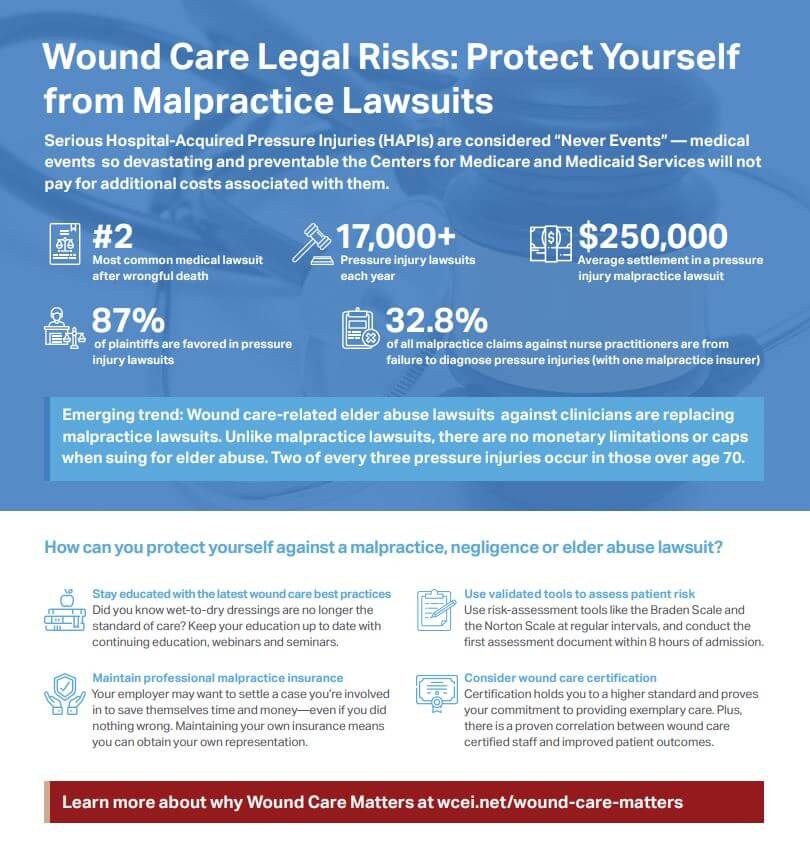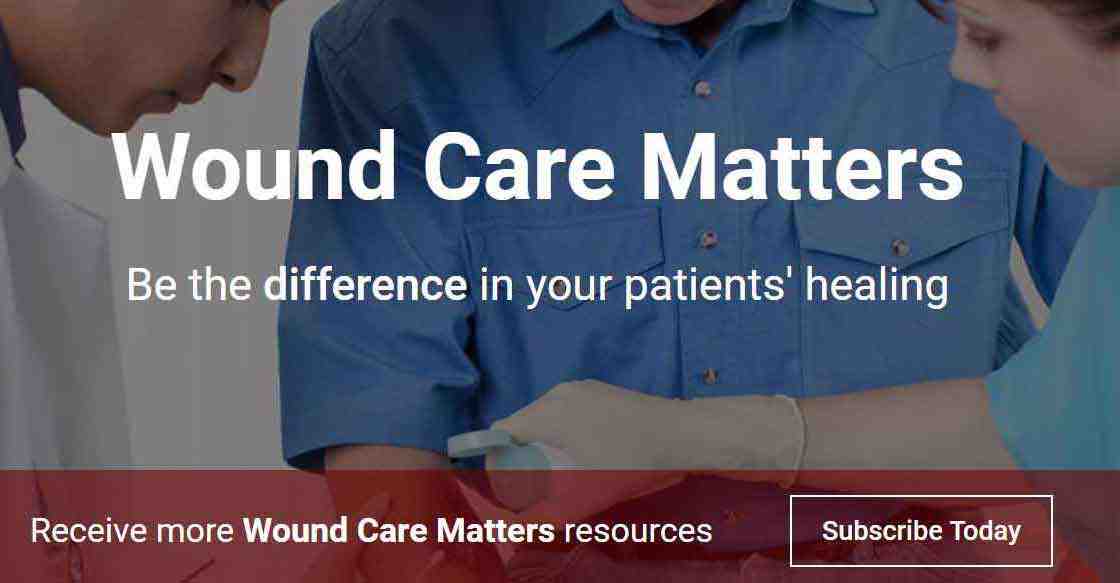Editor's note: We have partnered with The Wound Care Education Institute to raise awareness about the devastating effects of wound care knowledge gaps in the U.S. healthcare system. Our goal is to educate clinicians to empower themselves and their organizations to combat these gaps through wound care education.
Providing the best possible care for patients is the goal of every dedicated clinician.
Whether you're an experienced or brand-new wound care nurse, are certified in wound care or not, work in acute care, long-term care or the ambulatory environment -- you have an ethical and legal obligation to provide optimum care, along with personal pride in your practice. Providing substandard wound care cannot only harm patients, it can result in a patient or family members taking legal action against you and other clinicians involved in the patient's care plan, said Nancy Brent, JD, MS, RN, a nurse attorney who represents nurses in her law practice in Wilmette, Ill.
"The legal fallout from litigation pertaining to patient care can range from being sued for medical malpractice or professional negligence, in addition to the fees related to legal representation and damages owed if you're held legally responsible," she said. "You'll also be reported to your state regulatory agency that oversees your license, whether you've been legally cleared or not. State regulatory boards will investigate cases to determine if you violated your state and professional practice act. You could lose your license if found in violation of your practice act, even if the patient did not incur an injury."
Another concern for clinicians is a new legal wrinkle some face when treating elderly patients. "One trend we're seeing now is if the patient is an elder, some clinicians are not being sued for malpractice, they are now being sued for elder abuse," said Melanie L. Balestra, NP, Esq., who practices healthcare law in Irvine and Newport Beach, Calif., in the Law Offices of Melanie Balestra. "The reason is there are monetary limitations, known as caps, regarding damages with malpractice cases. However, there are no monetary limitations or caps with cases pertaining to elder abuse." Wound care also is an area of healthcare seeing a large increase in malpractice cases, Balestra said. Some of the high-risk areas usually examined in wound care-related cases include:
- Treatment and care: Patient did not receive the appropriate treatment or care
- Communication failures: Clinician to patient and family, or clinician to clinician
- Medication administration: Failures in administering medication
- Informed consent: Not obtained, and/or not charted
- Documentation: Errors and omissions
Know your evidence-based treatments
[caption id="attachment_55729" align="alignright" width="288"] Click here to download and read our wound care legal risks info graphic.[/caption] One way to expand your clinical knowledge and skill, according to Brent, is to become certified in wound care. "Even if certified, it's extremely important to keep up with the latest standard of practice by reading journals, taking relevant continuing education courses, and recertifying when required," she said. "Once certified, you will be held to a higher standard of care. However, don't be afraid to get certified, as it's a badge of honor and shows a commitment to providing exemplary care." All wound care nurses, according to Balestra, should maintain their own professional malpractice insurance. "Sometimes employers will want to settle a case you're involved in to save themselves time and money - even if you did nothing wrong," she said. "However, you may not want to settle. When you carry your own insurance, you can obtain your own attorney to represent you." Linda Farmer, MSN, CNOR, RNFA, CWS, an acute care nurse practitioner with the Medical Arts Surgical Group/Anderson Wound Healing Center in Meridian Miss., has worked in wound care and surgery for 15 years. She notes that a crucial way to reduce the risk for legal liability is by engaging in safe wound care practice.
Click here to download and read our wound care legal risks info graphic.[/caption] One way to expand your clinical knowledge and skill, according to Brent, is to become certified in wound care. "Even if certified, it's extremely important to keep up with the latest standard of practice by reading journals, taking relevant continuing education courses, and recertifying when required," she said. "Once certified, you will be held to a higher standard of care. However, don't be afraid to get certified, as it's a badge of honor and shows a commitment to providing exemplary care." All wound care nurses, according to Balestra, should maintain their own professional malpractice insurance. "Sometimes employers will want to settle a case you're involved in to save themselves time and money - even if you did nothing wrong," she said. "However, you may not want to settle. When you carry your own insurance, you can obtain your own attorney to represent you." Linda Farmer, MSN, CNOR, RNFA, CWS, an acute care nurse practitioner with the Medical Arts Surgical Group/Anderson Wound Healing Center in Meridian Miss., has worked in wound care and surgery for 15 years. She notes that a crucial way to reduce the risk for legal liability is by engaging in safe wound care practice.
"Remaining current on the latest wound care practices via continuing education, literature review, following and participating in research, and practicing excellent wound-care specific documentation is essential," Farmer said. "Wounds should be measured and progress recorded in an organized manner for the duration of the treatment and a plan of care delineated so you can know if the patient's healing is progressing, and if it's not, what's next. If possible, period photographs should be taken after obtaining informed consent, of course."
Important stats to know
- According to a 2016 national healthcare safety report, one in nine malpractice cases between 2010 and 2014 involved a medication issue.
- From 2009 to 2013, more than 7,100 malpractice cases involved communication failures.
- More than 2.5 million people in the U.S. develop pressure ulcers annually in acute care, based on data from the federal Agency for Healthcare Research and Quality.
- In 2009, the presence of pressure ulcers in all long-term care patients nationally was 7.5% at a cost of more than $3.3 billion.
- Failure to diagnose accounted for 32.8% of all malpractice claims against nurse practitioners with one malpractice insurer, according to the Pennsylvania-based Nurses Service Organization.
Learn more about why Wound Care Matters today.
Prepare for the CWCN exam with the Wound Care Nursing Certification Review Course.
Nurse.com offers a fully online self-paced prep course.







